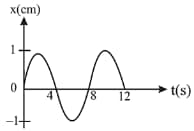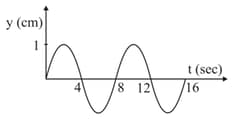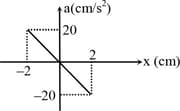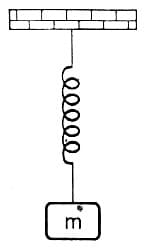Equation of SHM
Equation of SHM: Overview
This topic covers concepts, such as, Circular Motion and SHM, Equation of SHM, Acceleration-Displacement Graph in SHM & Acceleration-Time Graph in SHM etc.
Important Questions on Equation of SHM
The ratio of the magnitudes of maximum acceleration to the corresponding velocity of a body undergoing simple harmonic motion, is
The graph of a particle undergoing simple harmonic motion is as shown in the figure.

The acceleration of the particle at is
What will be the initial phase of simple harmonic motion represented by the equation .
If two SHMs of different amplitudes are added together, the resultant SHM will be a maximum if the phase difference between them is:
Two particles execute simple harmonic motions of same amplitude and frequency along the same straight line. They cross one another when going opposite directions. The phase difference between them when their displacements are one half of their amplitudes is then:
Graph between velocity and displacement of a particle, executing S.H.M. is
Initial phase of the particle executing SHM with is:
When two particles executing SHM are overlapped in opposite phase then resultant amplitude will be
The displacement of two particles executing SHM are expressed as and then at both are
Two simple harmonic motions have displacements and are superimposed on each other. Resulting amplitude will be.
The figure below shows the displacement vs time plot of a particle undergoing simple harmonic motion. The acceleration of the particle at time sec would be

Suppose a particle P is moving uniformly on a circle of radius A with the angular speed . The sense of rotation is anticlockwise. If the , it makes an angle of with the positive direction of the x-axis. In time , it will cover a further angle .What is the projection of position vector on the X-axis at time .
If we tie a stone to the end of a string and move it with a constant angular speed in a horizontal plane about fixed point, the stone would perform a :
If the particle is moving in circular motion under SHM, then its x-projection is depending upon
The x-projection for a certain particle in circular motion under SHM with period of , amplitude of oscillation is and initial phase of is
The acceleration-displacement graph of a particle executing simple harmonic motion is shown in the figure. The frequency of oscillation is

A point mass is suspended by a massless spring of constant . The point mass is released from rest at , when elongation in the spring is 15 cm. The equation of displacement of particle as a function of time is (Take

The ratio of maximum acceleration to maximum velocity in a simple harmonic motion is At, the displacement is What is the maximum acceleration? The initial phase is .
Two particles and describe simple harmonic motions of the same period, same amplitude, along the same line about the same equilibrium position . When and are on opposite sides of at the same distance from , they have the same speed of in the same direction. When their displacements are the same, they have the same speed of in opposite directions. The maximum velocity in of either particle is
Which of the following is correct about Simple Harmonic Motion (SHM) along a straight line?
